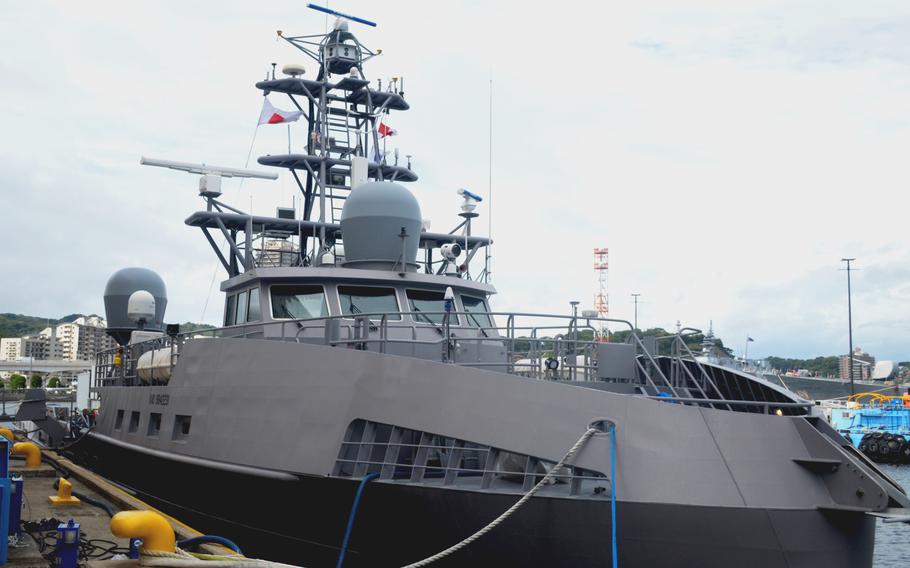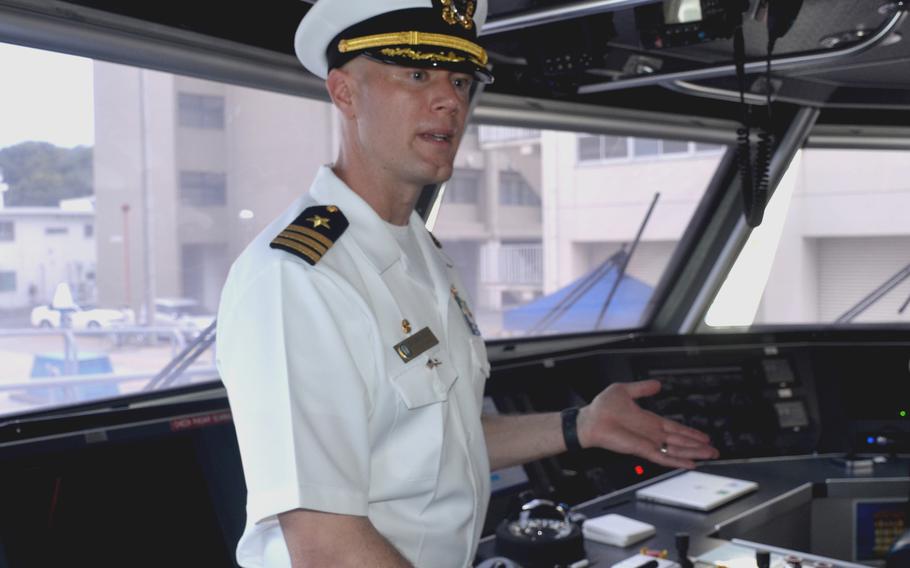
The USV Ranger, an unmanned surface vessel, completed its first trip to Yokosuka Naval Base, Japan, with the USV Mariner on Sept. 18, 2023. (Alex Wilson/Stars and Stripes)
YOKOSUKA NAVAL BASE, Japan — Two of the U.S. Navy’s first autonomous ships arrived at the home of the U.S. 7th Fleet on Monday, a journey across the Pacific that marked several firsts and tested the ships’ durability.
The USV Ranger and USV Mariner, both unmanned surface vessels homeported at Naval Base Ventura County, Calif., arrived at Yokosuka after several weeks of operations in the Indo-Pacific.
The ships over the past month participated in exercises like Large Scale Exercise 2023 — operating in conjunction with the aircraft carrier USS Carl Vinson and its strike group — while Navy evaluated the new technology, according to Cmdr. Jeremiah Daley, head of Unmanned Surface Vessel Division One.
“During these operations, we seek to gather new insights into these emerging technologies to provide essential learning opportunities for our leadership to set a course for future unmanned projects and additional prototypes; and eventually full integration into fleet operations,” Daley told media pierside at Yokosuka on Thursday.

Cmdr. Jeremiah Daley, commander of Unmanned Surface Vessel Division One, discusses the USV Ranger on the ship's bridge at Yokosuka Naval Base, Japan, on Sept. 21, 2023. (Alex Wilson/Stars and Stripes)
The unmanned vessels’ long journey also allowed the Navy to gather data from the ship’s autonomous features, and on the durability of the ships’ sensor suites, mechanical equipment and other systems, Daley said later aboard the Ranger.
Part of the Navy’s Ghost Fleet Overlord program — formerly headed by the Defense Department’s Strategic Capabilities Office and aimed at developing autonomous capabilities — the two ships can be crewed or operated remotely. When crewed, the ships typically have both sailors and civilian contractors aboard, according to division spokesman Ensign Pierson Hawkins.
The Ranger and Mariner are the Navy’s first and third USVs, respectively, and represent different stages of experimentation. Built by Gulf Craft in Louisiana, the ships are essentially fast supply vessels that would carry cargo or personnel to offshore sites such as oil rigs.
The Strategic Capabilities Office designed Ranger, but Navy input into Mariner’s construction allowed it to “integrate a few things into the vessel” and free up space for more technology and other capabilities, according to Daley.
He said he could not elaborate further on the two ships’ equipment or capabilities other than that they were “similar.”
Daley also couldn’t comment on the specifics of past operations, such as their exercise performance the past month, but described the ships as “force multipliers.”
Initially designed as “simply a truck” intended for transportation, the ships now specialize in surveillance and reconnaissance in underwater, surface and aerial environments, he said.
In one scenario, a guided-missile destroyer and two USVs could potentially replace three destroyers on a “tactical level,” Daley said. The swap would represent a fraction of the cost and manpower needed to field three destroyers.
The ships could also strengthen defenses against weapons such as ballistic missiles, he said, and the Navy is exploring that capability.
Primarily, the ships would allow the Navy to expand its presence in the Pacific.
“Having smaller, capable platforms that can connect tactically” allows manned vessels to operate at farther distances from potential enemies while “keeping the tactical picture and tactical relevancy,” he said.